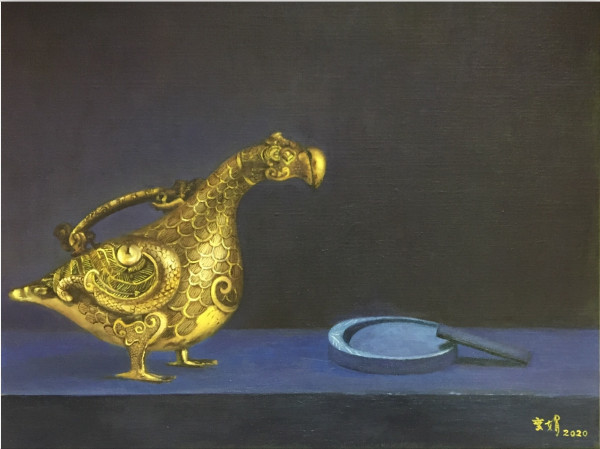Collect

Golden Bird Bringing Auspiciousness
Painting
Size 60.5 cm x 50 cm
NTD 210,000 (After Tax)
Certificate
M2025OOC000273PA

Artist
Chuan Chui Wu
Creation Year
2022
Condition Status
Well
Supplier
POST WINGS
Introduction
The inspiration for "Golden Bird Presenting Auspiciousness" comes from the shape imagery of ancient Chinese wine vessels, particularly the large ceremonial vessels that were prevalent from the Shang Dynasty to the Western Zhou. The piece resembles a phoenix, with a head adorned with the lid design of ancient artifacts, echoing the solemn atmosphere of ancestral worship during the Spring and Autumn and Warring States periods. It features gold and silver patterns that are both luxurious and elegant, with the bird's head slightly raised, gazing at the world with a sidelong glance, exuding a dignified yet charming and intriguing vitality.
The work also integrates the cultural significance of inkstones. Since the Wei, Jin, and Southern and Northern Dynasties, inkstones have carried the spirit and aesthetic tastes of literati, closely intertwined with wine culture. When scholars and elegant gentlemen delight in wine and song, they often accompany themselves with inkstones, transforming their emotions into poetry; while travelers express their feelings through wine, channeling their sorrows of parting. The creation juxtaposes drinking and ink grinding, symbolizing the release of the spirit and the source of creativity.
"Golden Bird Presenting Auspiciousness" not only recreates the noble aura of bronze ritual vessels but also presents a transcendent dialogue through the cultural intersection of "wine" and "inkstone," allowing viewers to experience the integration of ancient ceremonial music civilization and the sentiments of literati while appreciating it.
The work also integrates the cultural significance of inkstones. Since the Wei, Jin, and Southern and Northern Dynasties, inkstones have carried the spirit and aesthetic tastes of literati, closely intertwined with wine culture. When scholars and elegant gentlemen delight in wine and song, they often accompany themselves with inkstones, transforming their emotions into poetry; while travelers express their feelings through wine, channeling their sorrows of parting. The creation juxtaposes drinking and ink grinding, symbolizing the release of the spirit and the source of creativity.
"Golden Bird Presenting Auspiciousness" not only recreates the noble aura of bronze ritual vessels but also presents a transcendent dialogue through the cultural intersection of "wine" and "inkstone," allowing viewers to experience the integration of ancient ceremonial music civilization and the sentiments of literati while appreciating it.
Video Intro
None
Exhibition Resume